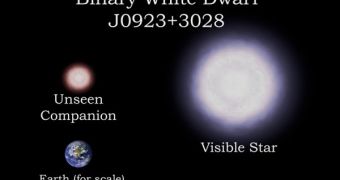Harvard-Smithsonian Center for Astrophysics (CfA) researchers, after finding the first hypervelocity stars getting out of the Milky Way, announced that they have spotted as much as a dozen double-star systems.
Half of the new-found binary stars are merging and could explode as supernovae, sometimes in the astronomically near future, and all of them consist of two white dwarfs.
But these white dwarfs are far lighter than they normally should be – only one fifth of the Sun's mass, and this is because they are made almost completely out of helium, while normal white dwarfs are made of carbon and oxygen.
Carlos Allende Prieto, an astronomer at the Instituto de Astrofisica de Canarias in Spain and a co-author of the study, said that “these white dwarfs have gone through a dramatic weight loss program.
“These stars are in such close orbits that tidal forces, like those swaying the oceans on Earth, led to huge mass losses.”
These white dwarfs turn around so close to each other, that they stir the space-time continuum, thus creating gravitational waves.
The waves carry away orbital energy, the stars keep spiraling closer together and eventually, half of these systems should merge.
The researchers calculated that the tightest 'duo', which orbits once every hour, should merge in almost 100 million years.
Smithsonian astronomer and co-author Mukremin Kilic, said that “we have tripled the number of known, merging white-dwarf systems.
“Now, we can begin to understand how these systems form and what they may become in the near future.”
A white dwarf is what's left after a sun-like star dies that exhausted its nuclear fuel – the hot core of the star.
White dwarfs are very dense, containing the mass of a sun into a sphere the size of Earth.
Smithsonian astronomer Warren Brown, lead author of the two papers reporting the find said that “these are weird systems - objects the size of the Earth orbiting each other at a distance less than the radius of the Sun.”
If two white dwarfs merge, their combined mass could cause them to explode as a Type Ia supernova.
The CfA researchers suggest that the merging double-star systems that they have discovered, could become underluminous supernovae – a rare kind of supernova, 100 times less bright that a normal Type Ia supernova and throwing out only one-fifth as much matter.
Brown explained that “the rate at which our white dwarfs are merging is the same as the rate of underluminous supernovae - about one every 2,000 years.
“While we can't know for sure whether our merging white dwarfs will explode as underluminous supernovae, the fact that the rates are the same is highly suggestive.”
Watch an animation of the future merging of the white dwarfs here.

 14 DAY TRIAL //
14 DAY TRIAL //